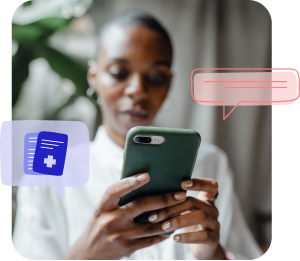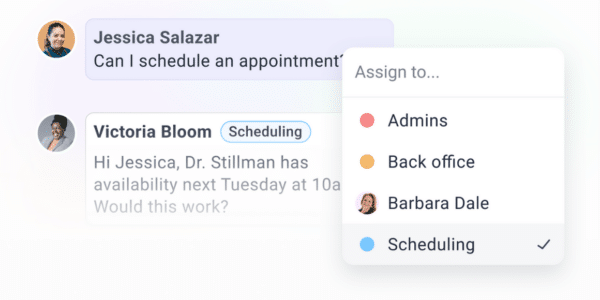Communication between providers plays a crucial role in delivering optimal patient care. Coordination of care and the ability to exchange pertinent information efficiently and securely can mean the difference between a positive and negative outcome for a patient. Gone are the days of relying solely on phone calls, fax machines, and the EHR alone to collaborate with colleagues. However, a systematic review of the literature found that direct communication between inpatient physicians and PCPs occurred during only 3–20% of hospitalization, highlighting the need for more effective communication methods such as texting.

Care teams, both in their make-up and in individual member responsibilities, can vary wildly, practice to practice.
Over time, it has become less and less efficient to rely solely on traditional communication channels when the health of patients require much more flexible means of connecting with speed.
Asynchronous communication that is simple has established a strong footing for patient communication. Until just recently, regulatory bodies hadn’t caught up to establish if texting patient information is allowed when care teams are communicating with one another. The latest update from The Centers for Medicare and Medicaid Services (CMS) in February 2024 has acknowledged the necessity of texting and adjusted adjusted its rules as they pertain to communication between care team members.
Let’s get into what the changes mean.
2024 CMS update: Texting patient information is allowed when staff at hospitals and CAHs communicate

In an official memo on February 8, 2024, the Centers for Medicare & Medicaid Services (CMS) at the Department of Health and Human Services (HHS) provided clarification and updates to policies surrounding the texting of patient information and orders.
This memo clarified that texting patient information is allowed when healthcare staff communicate.
Beneficial for both providers and patients alike, this pivotal update reflects the evolving landscape of healthcare communication for hospitals and critical access hospitals (CAHs). With the move, CMS has acknowledged the indispensable role of modern technology in facilitating efficient, secure, and compliant communication among health care team members.
What does the CMS update on texting mean for healthcare organizations?
Under the new guidance, effective immediately, healthcare providers are permitted to send patient information and orders via SMS text to other members of the care team, provided they use a secure texting platform that complies with HIPAA and the HITECH Act Amendment 2021.

Simple, secure internal chat
Safely share patient information with other care team members with OhMD.
Order entry through the EHR is still preferred
This shift not only demonstrates CMS’s commitment to embracing technological advancements but also ensures that such practices do not compromise care. While a big step forward, the update also notes that entering orders via the EHR is the optimal workflow according to the governing body.

Computerized Provider Order Entry (CPOE) remains the preferred method for entering orders due to its immediate integration into electronic health records (EHRs), ensuring orders are dated, timed, authenticated, and promptly recorded.
Nevertheless, CMS acknowledges the value of secure texting as an alternative to CPOE.
Given its enhanced encryption and interface capabilities, texting between care team members can significantly expedite treatment processes and reduce the burden on clinicians.
How CMS landed at the new SMS guidance
Historically, the healthcare sector has grappled with the dual challenges of maintaining patient confidentiality and ensuring rapid communication within care teams. CMS’s initial guidance in 2018 underscored these challenges, particularly highlighting concerns around privacy, record retention, and system integrity with the practice of texting patient orders. However, recognizing the advancements in secure texting technology, CMS has revisited its stance, offering healthcare providers the flexibility to utilize HIPAA-compliant secure texting platforms (STPs) while adhering to the Conditions of Participation (CoPs) for inpatient and outpatient medical records.
Secure, Compliant Texting: A Tool for Enhanced Patient Care

The adoption of secure texting platforms for colleague-to-colleague communication is more than a mere policy update. Affirming that texting patient information is allowed when colleagues communicate shows that CMS recognizes that compliant texting streamlines communication, reduces delays in care, and ensures that healthcare providers can swiftly share critical patient information with the intended recipient without compromising security or privacy.
The American Hospital Association (AHA) has lauded this change, recognizing it as a significant step forward in improving patient care and provider efficiency through the use of secure messaging apps and analytics, as well as the use of their own devices.
Upholding Security and Integrity Safeguards
To align with these updated guidelines, healthcare providers must diligently assess and maintain the security and integrity of their secure text message platforms.
This involves implementing systems that not only comply with HIPAA and the CoPs but also safeguard the confidentiality and privacy of patient information.

Regular audits and updates to these systems will be crucial in mitigating risks and enhancing the quality of care in the ever-evolving healthcare industry.
This is especially true when communicating between colleagues through the use of a secure messaging platform on a mobile device.
The technical safeguards of the HIPAA Security Rule must be met to ensure proper authorization for access to patient information.
Choosing a HIPAA compliant secure texting platform that complies with CMS guidelines
The recent updates from the Centers for Medicare & Medicaid Services (CMS) regarding the secure texting of patient information and orders have paved the way for significant enhancements in healthcare communication and coordination. In line with these updates, secure texting platforms that offer colleague chat and EHR integrations, like that of OhMD, emerge as critical tools.
OhMD Secure Internal Chat: Streamlined Communication in Compliance with CMS PHI Guidelines
OhMD’s Secure Internal Chat is ready-made for the new CMS guidance.

OhMD offers a platform that not only aligns with CMS’s Conditions of Participation (CoPs) but also massive flexibility and real-time communication between care team members.
This ensures that healthcare providers can share patient information and orders swiftly and securely.
Improving response times and care quality without compromising privacy or security can be achieved through the streamlined workflows made possible by the platform.
Physician to Physician Communication: Enhancing Care Coordination and Team Collaboration
Effective care relies on the seamless collaboration of multidisciplinary teams.
With the CMS updates emphasizing the importance of secure texting for patient orders and information, OhMD’s Secure Internal Chat facilitates this collaboration by providing a streamlined communication channel.

This tool enables instant sharing of critical patient data among physicians, nurses, and specialists, ensuring that all team members are on the same page, thereby enhancing patient engagement, care coordination, and outcomes with the use of appointment reminders and other patient-friendly features.
Ensuring Secure and Efficient Care Transitions
The CMS guidelines highlight the necessity of secure and efficient communication for care transitions.

OhMD’s colleague chat directly supports this need by offering a secure platform for exchanging information during crucial patient handoffs.
This capability minimizes the risks associated with care transitions, such as miscommunication or delays, thereby safeguarding continuous and coordinated care delivery.
Empowering Clinicians with Timely Information
In the context of CMS’s push for integrated and efficient healthcare communication systems, OhMD’s Secure Internal Chat stands out by providing medical professionals with immediate access to patient information.

This not only aligns with the CMS’s vision for utilizing technology to enhance patient care but also significantly aids in timely clinical decision-making.
The ability to access and share information instantaneously empowers clinicians to make informed decisions swiftly, leading to better patient outcomes.
The 2024 CMS Texting Update and Staying HIPAA Compliant

Texting has gained popularity due to its ease of use and real-time nature. However, concerns have arisen regarding the security of text messages and their compliance with HIPAA requirements. As healthcare professionals, it is essential to maintain patient privacy and protect sensitive information, including health data, called PHI or ePHI. The Health Insurance Portability and Accountability Act (HIPAA) was enacted to ensure the privacy and security of patients’ health information, including when communicating through electronic communications such as text messaging. It sets standards for the protection of individually identifiable health information and establishes guidelines for healthcare providers to follow, including the proper handling of personal information in accordance with the 2024 CMS patient texting update.
No matter the app, HIPAA compliance is a two way street

Therefore, HIPAA rules are critical to understand as this change is enacted. As every healthcare organization is different, we recommend becoming familiar with the official HIPAA documentation and how it applies to your practice and patient information. Regular compliance checks of both software your organization uses, as well as your communication workflows must be considered. Continual education among care team members can be a huge help to organizations.
The 2024 CMS update on texting within the care team is a big leap forward for communication colleague-to-colleague, doctor-to-doctor, care team member to care team member. The changes made indicate acknowledgement that secure texting platforms are more and more critical in daily healthcare workflows and in delivering optimal care outcomes.

Care coordination made easy
Use OhMD to securely share patient information with your team members.
At OhMD, we strive to offer up-to-date, relevant, and factual information, the rapidly evolving nature of patient communication technology means that details can change, and new insights emerge constantly. Our articles, insights, and guides are here to inspire your journey, not to serve as definitive legal or security compliance advice.


